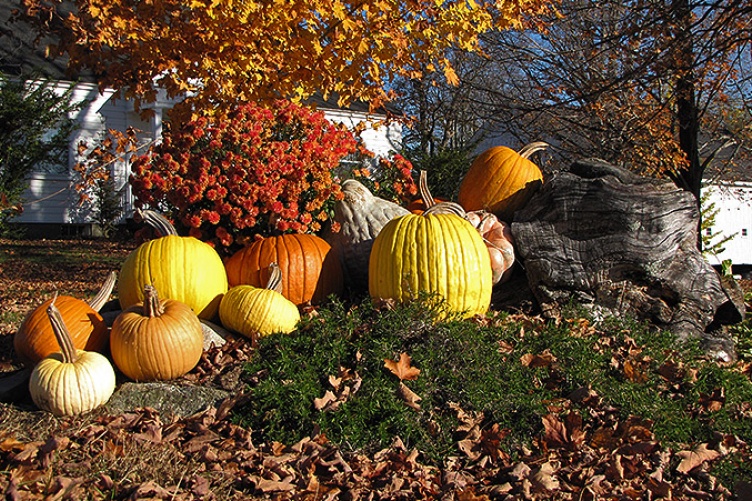
J. Brent Loy’s cucurbit breeding program at the University of New Hampshire, largely funded by the NHAES, represents the longest continuous squash and pumpkin breeding program in North America. The 54 varieties of melons, squash, gourds and ornamental pumpkin released by UNH during the past 15 years have had a major impact on agriculture in the Northeast. In 2014, the wholesale value of cucurbit seed marketed from varieties with UNH parentage was more than $2 million. The value of farm produce derived from those varieties would be several fold that of seed sales.
In addition to breeding improved varieties as replacements for existing varieties, many of our new introductions represent novel varieties that were not in previous existence, and thus, may expand vegetable acreage and provide new sources of income for growers. Examples are Goblin, a multicolored egg gourd mix grown on productive bush plants; Owls Eye, a light yellow pumpkin; Moonshine, the first large white pumpkin in the Cucurbita pepo species with a robust stem; and Sunlight, a darker, small yellow pumpkin being introduced this fall. Stems of ornamental pumpkins in the larger size categories frequently do not hold up well during harvest and transport, and stems often shrivel within a few weeks of harvest, reducing their market value. As a result of breeding research at UNH and collaboration with several seed companies, at least six new pumpkin varieties will be released in the next two years with improved stem strength and integrity along with having powdery mildew resistance (PMR).
In melons, Loy and his associates have bred an early Crenshaw-type melon with yellow skin and sweet orange flesh with good marketing potential for local markets throughout the northern United States. Seed of this new melon, along with two cantaloupe varieties with early maturity, are being increased for commercial introduction. Currently, there are more than 20 varieties of commercial melons offered for sale in the Northeast that contain breeding lines developed through research supported by NHAES. Many of these are varieties with early maturity, which expands the market window for melon production in the Northeast.
Over the past four decades, a large portion of squash/pumpkin acreage and production for processing has shifted from several states in the Northeast to the Midwest, chiefly Illinois. This has resulted concomitantly in a shift from use of Golden Delicious-type varieties of the species Cucurbita maxima to Dickinson Field strains within the species C. moschata. Concentration of production acreage of a crop in a single region exposes that crop to a greater propensity for disease and insect problems, and according to recent reports from extension specialists in the Midwest, disease pressures on processing pumpkins are indeed increasing, compromising the health of the industry. Developing new processing varieties with the favorable processing attributes of Golden Delicious strains, the high yield capacity of Dickinson Field strains, greater regional adaptability and with improved disease and insect. Through research supported by the NHAES, bush strains of C. maxima processing squash were developed which are being used as the female parent in crosses to selected strains of C. moschata. Several of the hybrids derived from this parentage display rapid leaf canopy development, high productivity, resistance to squash vine borer, tolerance against predation by squash bugs, tolerance to foliar diseases, and relative freedom from fruit rots.
One hybrid in particular, a cross of NH65, a bush Golden Delicious strain, to SC936, a Dickinson Field strain of C. moschata provided by Rupp Seeds, has performed exceptionally well. In field trials, this hybrid produced 40 percent increase in fresh weight and a 90 percent increase in dry weight as compared to the SC936 Dickinson field strain. Moreover, there was no plant loss to insects and disease in the hybrid and the percent dry weight of fruit averaged 9.3, a level which provides much better consistency of cooked pie puree than the value of 6 percent for SC936. Concomitantly, new bush lines of C. maxima are being developed with better flesh color, higher dry matter (equals higher starch) and stronger branching habit. It should be possible in the near future to develop interspecific varieties not only for pie processing but also for baby food puree, frozen pack processing, and even for the fresh market. The introduction of interspecies hybrids with greater productivity, nutritional value and pest resistance not only could provide growers with a more profitable squash crop in multiple growing regions, but in particular, could help reinvigorate the processing industry in the Northeast.

















































